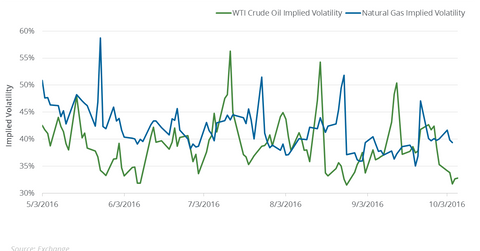Crude Oil and Natural Gas: Analyzing Implied Volatilities
For natural gas (UNG) (DGAZ) (BOIL) (FCG) (UGAZ) (GASL), its implied volatility was 39.4% on October 7, 2016. Its 15-day average implied volatility is 38.5%.
Oct. 10 2016, Published 12:30 p.m. ET

Crude oil’s implied volatility
Crude oil’s (UWTI) (USO) (OIIL) (USL) (SCO) (DWTI) implied volatility was 32.8% on October 7, 2016. Its 15-day average implied volatility is 37.6%. Crude oil’s current implied volatility is 12.6% below its 15-day average.
Crude oil’s implied volatility rose to 56.3% on July 13, 2016. Since then, its implied volatility has fallen 41.7%. Over this period, US crude oil active futures contracts have risen 11.3%.
From September 30 to October 7, crude oil’s implied volatility fell 6.9%. During this period, West Texas Intermediate crude oil gained 3.3% due to the fall in crude oil inventories and OPEC’s deal—as we discussed in Part 1 of this series.
What about natural gas?
For natural gas (UNG) (DGAZ) (BOIL) (FCG) (UGAZ) (GASL), its implied volatility was 39.4% on October 7, 2016. Its 15-day average implied volatility is 38.5%. Its current implied volatility is 4.2% above its 15-day average.
Its implied volatility rose to 58.7% on May 25, 2016. Since then, it has fallen 32.9%. Since May 25, natural gas has risen 61.3%. Last week, natural gas November futures rose 9.9%, while the implied volatility fell 1.8%. The rise in prices corresponds to the forecast for cooler temperatures.
Energy ETFs
The analysis could be important for natural gas–tracking ETFs such as the ProShares Ultra Bloomberg Natural Gas ETF (BOIL), the Direxion Daily Natural Gas Related Bear 3X ETF (GASX), the United States Natural Gas ETF (UNG), and the Direxion Daily Natural Gas Related Bull 3X ETF (GASL).
It could also be important for crude oil–tracking funds such as the United States Oil ETF (USO) and the Credit Suisse X-Links WTI Crude ETN (OIIL).
